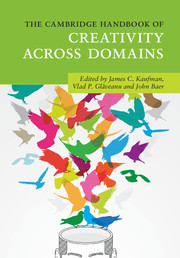Book contents
- The Cambridge Handbook of Creativity Across Domains
- The Cambridge Handbook of Creativity Across Domains
- Copyright page
- Dedication
- Contents
- Figures
- Tables
- Contributors
- Acknowledgments
- Part I Creativity and Domain
- Part II Creativity in the Traditional Arts
- Part III Creativity in the Sciences
- Part IV Creativity in Business
- Part V Newer Domains for Creativity Research
- 24 Intellectual Property
- 25 Gastronomy and Culinary Creativity
- 26 Tactical Creativity in Sport
- 27 Creativity in Non-Human Animals
- 28 Violent Innovation
- Part VI Creativity in Everyday Life
- Part VII Conclusion
- Index
- References
28 - Violent Innovation
Creativity in the Domain of Terrorism
from Part V - Newer Domains for Creativity Research
Published online by Cambridge University Press: 15 September 2017
- The Cambridge Handbook of Creativity Across Domains
- The Cambridge Handbook of Creativity Across Domains
- Copyright page
- Dedication
- Contents
- Figures
- Tables
- Contributors
- Acknowledgments
- Part I Creativity and Domain
- Part II Creativity in the Traditional Arts
- Part III Creativity in the Sciences
- Part IV Creativity in Business
- Part V Newer Domains for Creativity Research
- 24 Intellectual Property
- 25 Gastronomy and Culinary Creativity
- 26 Tactical Creativity in Sport
- 27 Creativity in Non-Human Animals
- 28 Violent Innovation
- Part VI Creativity in Everyday Life
- Part VII Conclusion
- Index
- References
Summary
Terrorism provides a rich yet understudied domain to examine creativity. Because violent ideological organizations must continue to generate covert and novel ways to recruit members, raise finances, and plan attacks, theories of creativity typically applied to more conventional organizations can also apply to terrorist organizations. The present effort reviews the extant literature on malevolent creativity, examining commonalities and differences about studying creativity in the domain of terrorism. Reviewing both lab-based and field-based research on terrorist creativity, we present a call for research to measure creativity in this domain.
- Type
- Chapter
- Information
- The Cambridge Handbook of Creativity across Domains , pp. 507 - 522Publisher: Cambridge University PressPrint publication year: 2017
References
- 4
- Cited by



